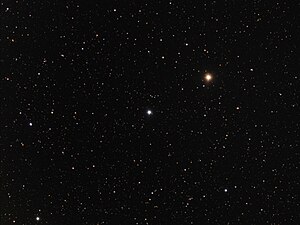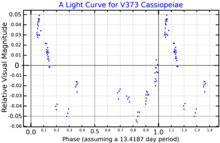V373 Cas is a binary star system in the northern constellation Cassiopeia. It is a suspected eclipsing binary with an apparent visual magnitude that decreases from a baseline of 6.03 down to 6.13.[3] The system is located at a distance of approximately 6,200 light years from the Sun, but is drifting closer with a radial velocity of around −25.5 km/s.[4]
 V373 Cassiopeiae (center) in optical light. The bright yellow star to the upper right of V373 Cas is ρ Cas. | |
| Observation data Epoch J2000 Equinox J2000 | |
|---|---|
| Constellation | Cassiopeia |
| Right ascension | 23h 55m 33.83878s[1] |
| Declination | +57° 24′ 43.8057″[1] |
| Apparent magnitude (V) | 6.03[2] |
| Characteristics | |
| Spectral type | B0.5II + B4III/V[2] |
| B−V color index | 0.155±0.005[2] |
| Variable type | Eclipsing?[3] |
| Astrometry | |
| Radial velocity (Rv) | −25.5±0.9[4] km/s |
| Proper motion (μ) | RA: −4.098[1] mas/yr Dec.: −0.101[1] mas/yr |
| Parallax (π) | 0.5267 ± 0.0583 mas[1] |
| Distance | approx. 6,200 ly (approx. 1,900 pc) |
| Orbit[5] | |
| Period (P) | 13.41921 days |
| Eccentricity (e) | 0.126±0.019 |
| Periastron epoch (T) | 2,420,801.98 JD |
| Argument of periastron (ω) (secondary) | 16±8° |
| Semi-amplitude (K1) (primary) | 106.7±2.7 km/s |
| Semi-amplitude (K2) (secondary) | 144.6±2.6 km/s |
| Details[6] | |
| A | |
| Mass | 18.6±2.4 M☉ |
| Surface gravity (log g) | 3.0±0.2 cgs |
| Temperature | 23,200±600 K |
| Rotational velocity (v sin i) | 130±10 km/s |
| Age | 7–8 Myr |
| B | |
| Mass | 14.2±1.9 M☉ |
| Surface gravity (log g) | 3.5±0.2 cgs |
| Temperature | 26,800±1,500 K |
| Rotational velocity (v sin i) | 60±5 km/s |
| Other designations | |
| Database references | |
| SIMBAD | data |

The binary nature of this system was announced in 1912 by Walter S. Adams.[9] It is a double-lined spectroscopic binary with an orbital period of 13.4 days and an eccentricity of 0.13.[5] The system was found to be variable in 1958 by C. Roger Lynds, and the variability cycle was shown to be related to the orbital period.[9] It has been described as a heartbeat star rather than an eclipsing system. This is a type of pulsating star where the pulsations are induced by the tidal attraction of a close companion.[10]
V373 Cas is composed of two hot blue-white giant stars that have exhausted their core hydrogen and expanded off the main sequence. Lyubimkov and colleagues analysed spectral and radial velocity to calculate that the stars were ~19 and ~15 times as massive as the Sun and the age of the system is around 7-8 million years old.[6] The primary component is the more evolved and now comes close to filling its Roche lobe when it is at periastron.[11]